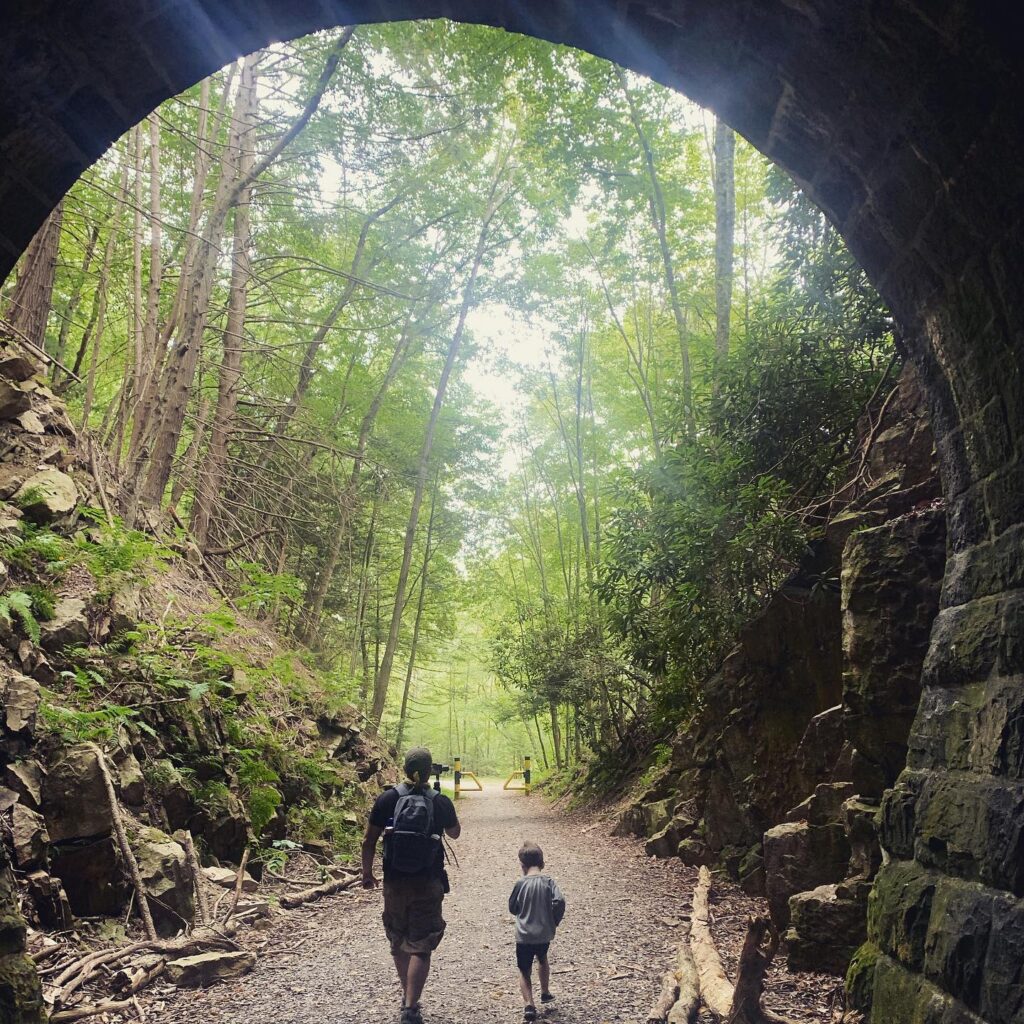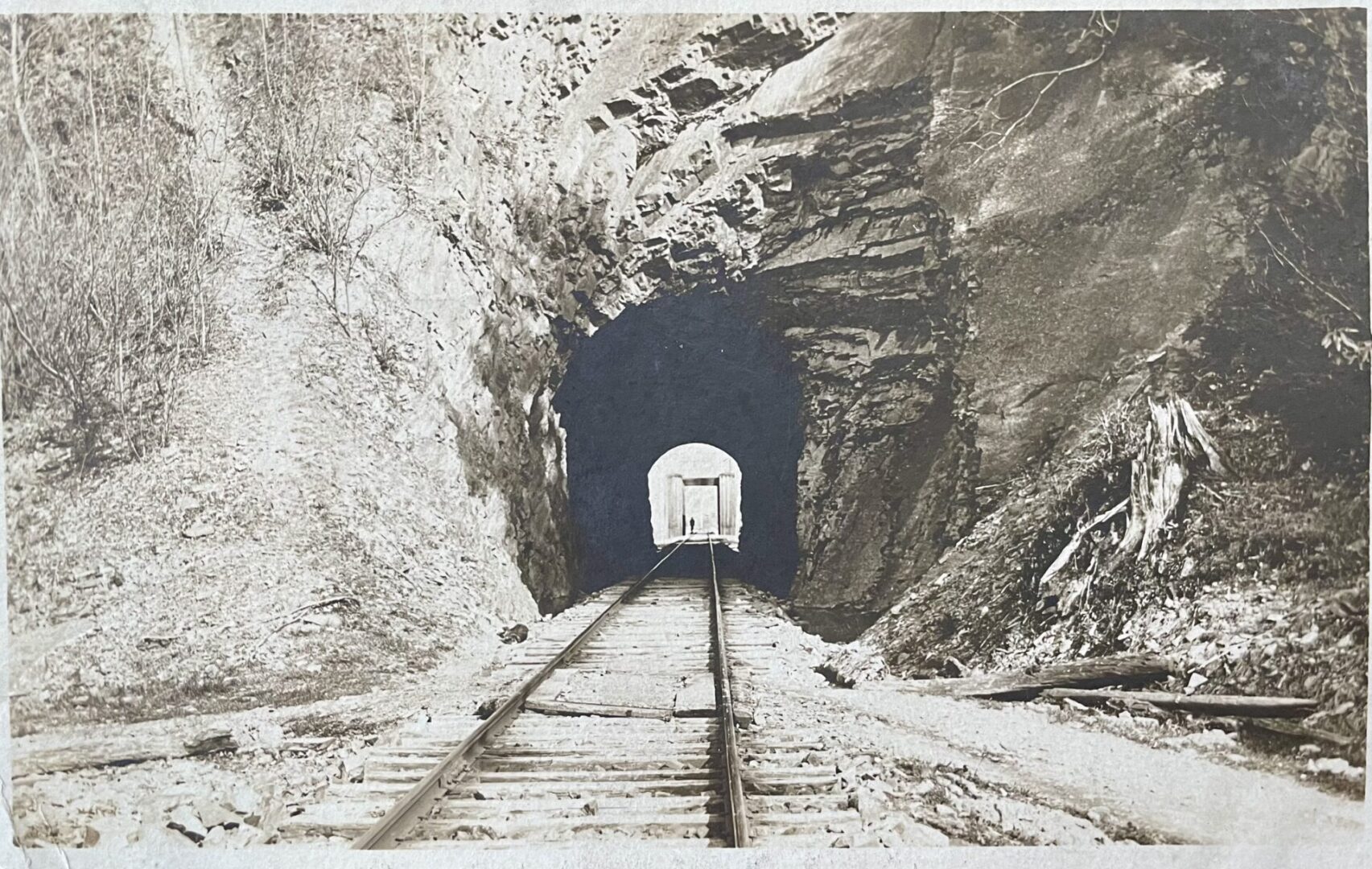The two tunnels at Coburn and in Poe Paddy State Park are a great way to reflect upon and experience railroad history in central Pennsylvania. Both tunnels were constructed in the 1870s for the Lewisburg, Centre, and Spruce Creek Railroad (LC&SC), which became the Lewisburg and Tyrone Railroad (L&T) circa 1880. These monuments continue to pay homage to the glory days of railroading. Imagine the countless excursions of engines, freight, and passengers that passed through these dark, cool tunnels while steaming through the Seven Mountains.
The now-abandoned railroad tunnel below Coburn, known as the Beaver Dam Tunnel, can be found on Tunnel Road, which meanders along Penns Creek, forming a horseshoe around the topography. Railroad engineers thought it most prudent to avoid such a curve and tunnel through the mountain instead. The 260-foot-long tunnel was constructed in the 1870s by “a strong force of hands,” including Irish immigrants. About 200 men labored to carve both “Paddy’s Mountain” and Beaver Dam tunnels between 1872 and 1877; the first locomotives would steam through them in 1877.
Prior to the arrival of the railroad, Coburn was known as “the Forks” due to its location where Elk and Pine creeks joined Penns Creek. Railroads needed to follow the watersheds, paths of least resistance, but in Seven Mountains, a couple of tunnels were inevitable. “The Forks” found itself along the new railroad due to the influential role of attorney and railroad director Colonel James Potter Coburn. Colonel Coburn, from Aaronsburg, played a leading role in establishing the railroad in Centre County, in particular through the small community at “the Forks,” which then took his name. His nephew became the ticket agent at the Coburn passenger station, which was also completed in 1877.
Over at Paddy Mountain Tunnel in 1873, an annual report for LC&SC stockholders noted that “rock in stratification” was encountered and that the strats, which were parted by small seams of sand, would require arching of up to half of the tunnel’s 320 feet in length. Paddy Mountain Tunnel was longer than the Beaver Dam Tunnel, which was only arched on the east side portal. Like the natural Coburn tunnel, the curved tunnel at Paddy Mountain was also partially natural until it was lined around 2015. The tunnel rehabilitation benefited Poe Paddy State Park visitors using the Penns Creek Rail Trail, hikers on the Mid State Trail, and bat species that needed protection.
In June of 1877, a writer for the Millheim Journal reported the “luxury” of “riding on the rail” through the Seven Mountains. The train “literally flew through the Beaver Dam Tunnel,’” crossed over several bridges, and powered through “Paddy’s Tunnel.” In another account, a passenger tried to kiss his girlfriend in the tunnel’s darkness, a romantic gesture no doubt, as wind swept through their hair and the engine steamed amidst the private moment. However, the tunnel was short enough that the couple was still found to be embraced in broad daylight, to the cheers of the other passengers.
July 4, 1877, “was a proud day in Penns Valley,” an occasion for formally inaugurating the Lewisburg, Centre, and Spruce Creek Railroad. An excursion train left Spring Mills (Rising Springs). The engine and tender pulled ten large railroad cars and gondolas with about 800 persons of “human freight.” The Farmers Mills Band was in the front car and the Millheim Cornet Band occupied the rear. They traveled merrily through the tunnels and made their way to Laurelton in about eighty minutes. Then they made their way back to the picnic grounds, where at least 4,000 people feasted and were entertained by five local bands. They erected a dancing floor, heard speeches, and even witnessed an impromptu wedding. A large contingent of the population steamed in from Union County in thirteen passenger cars full to the brim. Indeed “a good, social humor seemed to pervade the entire vast multitude of people.”

It is interesting that these local celebrations happened just weeks before the Great Railroad Strike of 1877 would turn violent. Railroad workers protested wage and job cuts. Spring Mills would even have to wait for a better turntable as theirs was burned during the riots at Pittsburgh.
By 1885, the Lewisburg and Tyrone Railroad had linked up with the Bellefonte, Nittany, and Lemont Railroad (BN&L) to connect Lewisburg (Montandon Station), all the way to Bellefonte along sixty-seven miles of rail. Unfortunately, this isolated section of track faced the challenges that all railroads faced as improved roadways, automobiles, and trucking took over. Shortly after Hurricane Agnes hit in 1972 and caused flooding across Pennsylvania, the remaining tracks east of Lemont were removed along the L&T, leaving the quiet tunneled monuments that we wonder at today.
To learn more about ways to experience railroad history in Centre County, join Local Historia in a video series called Hidden Happy Valley, Season 3, Episode 2: https://www.youtube.com/watch?v=r1CIjsBfjuo. T&G
Local Historia is a passion for local history, community, and preservation. Its mission is to connect you with local history through engaging content and walking tours. Local Historia is owned by public historians Matt Maris and Dustin Elder, who co-author this column. For more, visit localhistoria.com.
Sources:
“A Luxury.” Millheim Journal (Millheim, PA). June 21, 1877.
“Annual Report of L.C. & S.C. R.R.” Centre Reporter (Centre Hall, PA). July 10, 1873.
Bezilla, Michael. “The PRR’s Lewisburg & Tyrone Railroad: When Two Halves Didn’t Make a Whole.” The Keystone by PRRT&HS, Vol. 39, No. 1(Spring 2006): 18-40.
Centre Reporter (Centre Hall, PA). Nov. 29, 1872.
Manchester, Hugh. “The Big Spring.” Centre Daily Times (State College, PA). Jan 23, 2001.
“Excursion Incidents.” Centre Reporter (Centre Hall, PA). Aug. 23, 1877.
“The Fourth: The Lewisburg, Centre, & Spruce Creek Railroad Inaugurated.” Millheim Journal (Millheim, PA). July 12, 1877. https://panewsarchive.psu.edu/lccn/sn83008556/1877-07-12/ed-1/seq-3/#words=opening+railroad+Railroad




